Comparative Analysis of Substance Use Across Cyprus: Analyzes the Differences and Similarities in Substance Use Between North and South Cyprus
Abstract
This comparative study examines changes in substance use among high school students in Northern and Southern Cyprus, contrasting them with countries where The European School Survey Project on Alcohol and Other Drugs (ESPAD) had been conducted. This study using quantitative methods, it explores trends in cigarette smoking, e-cigarette use, alcohol consumption, and illicit drugs (cannabis, ecstasy, cocaine). Additionally, it investigates non-prescription drug use (anabolic steroids, tranquillizers/sedatives), comparing both regions and ESPAD data. Analysis employed percentage and frequency calculations through SPSS. The study highlights the need for continuous monitoring and adapting public health interventions to address evolving patterns of substance use in Cyprus. Observed shifts, such as increasing cannabis use and differential cocaine/heroin use patterns, emphasize the need for region-specific public health strategies and policies.
Keywords: Substance use, Cyprus, comparative analysis ESPAD
Introduction
Cyprus, despite its diminutive size, is presently grappling with substance utilization, a complex topic that exerts influence on individuals, households, and societies on either side of the island (Çakıcı Eş et al., 2020). This article examines the nuanced landscape of substance use in North and South Cyprus, aiming to elucidate the intricate historical, political, and sociocultural factors shaping divergent trends (Kyprianou et al., 2023; Tecel Tremeşeli, 2022).
The geographical proximity of North and South Cyprus presents a unique opportunity to examine how geopolitical divisions influence substance use patterns and experiences. Residents of each region face distinct challenges, opportunities, and realities shaped by this division. Understanding the historical, political, and socioeconomic contexts is crucial to deciphering the diverging trajectories of substance use in both regions (EMCDDA, 2014; Northern Cyprus Anti-Drug Commission, 2021). Factors like historical context, political divide, sociocultural influences, economic implications, and emerging trends all play a significant role in comprehending the island's overall drug use landscape.
Literature Review
Substance abuse transcends national borders, cultural norms, and socioeconomic divides, posing a complex and pervasive challenge (Lo et al., 2020; UNODC, 2018). Its ramifications extend far beyond individual health, impacting societal institutions and generating a multitude of issues demanding attention. This multifaceted problem manifests in both North and South Cyprus through the misuse of prescription drugs, cannabis, alcohol, cigarettes, and even novel psychoactive substances. Furthermore, the consequences of substance abuse extend beyond immediate health risks, encompassing economic burdens, healthcare system strain, criminal activity, and social stigma (Room, 2005).
The task of monitoring and comparing trends among countries is challenging and can only be done with the existence of reliable data of countries with common methodological protocol. European School Survey on Alcohol and Drug is such a reliable source to compare trends between European countries and groups of countries regarding substance use among 15-16-year-old students which has been conducted since 1995 and are repeated every four years, comparing results of Cyprus with ESPAD countries will give insight on the trends in cigarette smoking, e-cigarette use, alcohol consumption, and illicit drugs (cannabis, ecstasy, cocaine).
Smoking, E-cigarette Smoking and Alcohol Consumption in Cyprus
This research examines the occurrence of alcohol consumption, cigarette smoking and e-cigarette smoking among students in Northern Cyprus and compares the result with the national averages in Southern Cyprus and broader trends observed in ESPAD countries. It is crucial to comprehend these behaviours for the better health of public and societal prosperity, as stated by UNODC (2022). This study spotlights Northern Cyprus, a distinct region with unique demographic, cultural and socioeconomic features.
The main goal of this research is to explain the extent of student substance use in Northern Cyprus by analysing and comparing it with the trends in Southern Cyprus and ESPAD countries. By examining these trends will allow to clarify the scope of substance use activities in Northern Cyprus and identify and potential deviations from local, national and international norms. This comparative analysis offers valuable information especially for designing relevant policies and effective public health interventions.
While evaluating the well-being and health of young individuals, it is crucial to investigate their alcohol consumption, cigarette smoking and e-cigarette smoking patterns (Hefner et al., 2019; Hughes et al., 2015; Münzel et al., 2020). Such behaviours have a long-term impact on individuals and can lead to both immediate and long-term chronic health consequences. Thus, this section emphasizes the significance of comparing alcohol consumption, cigarette smoking and e-cigarette smoking patterns and rates among students in Northern Cyprus with the averages observed in Southern Cyprus and other ESPAD countries.
Northern Cyprus possesses unique social and cultural characteristics. The study conducted by Çakıcı et al. (2020) unveiled that the lifetime prevalence of alcohol consumption was 62.7% while the prevalence of illegal substance use was 72.1% in Northern Cyprus. On the other hand, smoking showed an 8% prevalence rate. These rates of drug use and alcohol consumption in Northern Cyprus are comparable to those in the US, and are higher than countries in Europe, Asia and Africa. In Addition, Kapardis et al. (2021) discovered some concerning trends among youth in Cyprus: 21% reported lifetime smoking, 16% had started cigarette smoking before the age of 14, and 18% had used illicit drugs at some point in their lives, with 2.5% reported of start before the age of 10. Furthermore, 7% admitted to using illicit drugs or consume alcohol at school in the previous year.
Understanding the underlying reasons and triggers of substance use behaviour among Northern Cypriot students requires comparing statistics with those in Southern Cyprus and ESPAD countries. Thus, this approach both highlights regional differences and also identifies potential trends, interventions and influences that may significantly impact the lives of young people across diverse regions.
The Use of Illicit Drugs in Europe and Cyprus
European universities have historically and traditionally been known as the main centres of learning intellectual development however, there is an alarming trend that has emerged: the increasing prevalence of illegal drug use among students (OECD/European Union, 2016). In the reports gathered from European Monitoring Centre for Drugs and Drug Addiction (EMCDDA) (2019, 2022), the growing use of illegal drugs issue has been highlighted and which attribute the trend to a variety of social, economic, and psychological factors rather than a single cause (Aresi et al., 2016; Skidmore et al., 2016). Different factors such as academic pressures, financial concerns, changing social dynamics, and a desire for exploration may be the factors that all contribute to this complex phenomenon. The sources cited below show the prevalence of illegal substance use among young people in Cyprus, particularly among those aged between 15-16, found to be relatively low when compared to other European countries (EMCDDA, 2022). While lifetime prevalence rates are encouraging, past-month use shows a different picture. Although cannabis use (1.4%) remains below when compared with various other European country averages, Cyprus has surprisingly showed high prevalence rates for amphetamines, cocaine, and especially ecstasy (EMCDDA, 2022). These results reveal the alarming increase in ecstasy use across Europe, and cocaine is also emerging as a potential concern due to the growing demand for treatment, especially among female users who have balanced and stable employment and occasionally use cocaine (Agorastos, 2010).
A research study conducted by Çakıcı et al. (2019a) examined how illicit drug usage among adults aged between 18-65 in Northern Cyprus changed in 2017 compared to previous years. The study's results showed significant increases in illicit drug use in several categories when compared with the data collected from 2003-2015 using the same data collection tool and strategy. Specifically, the research stated an increase in the usage of additional psychoactive substances (OPD) (14.9%), illegal drugs (11.7%), smoking (60.9%), and regular alcohol drinking (63.5%).
Notably, male gender, young age, Turkish origin, single living arrangements, lack of religious importance, and pre-existing alcohol or tobacco use emerged as risk factors for illegal drug use. Additionally, the study observed a negative perception of substance users among non-users, with individuals hesitant to interact or form friendships with them, further highlighting the social stigma surrounding such behavior. According to Çakıcı et al. (2019a), there has been an alarming increase in substance misuse in Northern Cyprus between the period of 2003 and 2017. This trend is consistent with a broader European pattern among students. It is imperative to comprehend the complex relationship of factors that propel this phenomenon to formulate effective methods of management and prevention.
Usage of Anabolic Steroids, Tranquilizers, and Sedatives as Non-Prescription Drugs
European students navigate an increasingly demanding landscape of academic and personal growth. The pursuit of academic excellence, coupled with the social and emotional challenges of emerging adulthood, presents a complex test of resilience. Amidst these pressures, an alarming and often overlooked epidemic is sweeping through European campuses: the non-prescription use of anabolic steroids, tranquilizers, and sedatives (EMCDDA, 2009). This phenomenon transcends individual health risks, threatening the very foundations of European education – intellectual development, personal growth, and the pursuit of knowledge. In terms of Kokkevi et al. (2008a) highlight the complex nature of the issue, and remind that it is situated across country boundaries, social groups, and cultural contexts. It not only jeopardizes students' physical health through anabolic steroid abuse but also raises critical questions about the demands and expectations placed on contemporary learners. Anabolic steroids pose well-documented about physical risks, research by Carrasco-Garrido et al. (2018) and Lehne et al. (2018) demonstrates the harmful effects of tranquilizers and sedatives on mental health.
Kokkevi et al. (2008b) conducted a study on this issue, collecting data from 18,430 adolescents in European countries, included Cyprus. The research study of target group being 16-year-old high school students. Their findings paint a concerning picture: anabolic steroid users exhibited higher rates of running away from home, suicidal ideation, and suicide attempts (in Cyprus and Greece). They reported easier access to steroids, perceived higher prevalence of use among peers, and increased absenteeism from school. Notably, students in Croatia, Slovakia, and Cyprus who did not use steroids reported higher academic performance compared to their steroid-using counterparts. A statistical analysis revealed higher lifetime prevalence of steroid use in Croatia and Cyprus compared to other participating nations.
Also, in terms of Çakıcı et al. (2017) found that their research findings, tranquilizers and sedatives are the most commonly used non-prescription drugs in Northern Cyprus after alcohol and illegal drugs. The aforementioned study observed a significant increase in the lifetime use of these substances compared to previous years. The authors emphasize that this trend is worrying, especially as these drugs require green prescriptions and supervised use.
Methodology
In this study compared substance usage prevalence of among high school students in both communities (the Turkish Cypriot and Greek Cypriot communities). In this study, the comparative scanning method, which is widely used to compare different cultures or societies, was used.
Research Aim and Questions
The primary aim of this study is to evaluate the prevalence rates of cigarette smoking, e-cigarette usage, alcohol consumption, illicit drug use, anabolic steroid use, tranquilizer use, and sedative use among students in Northern Cyprus and compare them with the averages reported in Southern Cyprus and ESPAD countries. This analysis will also examine any changes that have occurred over time.
Research questions of the study are presented below:
- RQ 1: What is the percentage of students who smoke cigarettes, e-cigarettes and drink alcohol in Northern Cyprus compared to the averages for Southern Cyprus and ESPAD countries?
- RQ 2: How much has the proportion of students using illicit drugs such as cannabis, ecstasy, cocaine etc. changed over time compared to the rates in Northern Cyprus, Southern Cyprus and ESPAD countries?
- RQ 3: What is the percentage of students in Northern Cyprus who use Anabolic Steroids, Tranquilizers or Sedatives as non-prescription medicines compared to the averages for Southern Cyprus and ESPAD countries?
Research Design and Data Collection Tools
The research gathered information from primary and secondary sources. Primary data came from the ESPAD survey, regularly conducted since 1995 among European high school students aged 15-16 (). The data for 2023 in Northern Cyprus was collected using the ESPAD survey in high schools. Secondary data sources include published studies and reports on the ESPAD web portal 1995 to 2019 (http://www.espad.org/espad-report-2019). Another secondary data source is based on the findings of the research conducted by Çakıcı et al. (2019a). This study examines the findings of substance use previous research conducted in Northern Cyprus.
Research Sample and Data Collection Procedure
Primary source data for 2023 was collected from the responses to the ESPAD survey of 763 students who voluntarily participated in the study from 6 districts through guidance services in Northern Cyprus high schools. Secondary source data were filtered by the researchers and categorized in Excel by examining the findings in the ESPAD reports and the findings of the research conducted by Çakıcı et al. (2019).
Analysis of Data
The data collected from the ESPAD research for 2023 Northern Cyprus was analysed using the percentage and frequency analysis method via SPSS. The percentage rates of the data for Northern Cyprus were processed into a previously created Excel database containing other secondary data, where the secondary data were processed categorically according to years. Thus, the averages of Northern Cyprus, Southern Cyprus and ESPAD countries were analysed using Excel data visualization tools.
Ethical Consideration
The study has been approved by the ethics committee of the Northern Cyprus Prime Minister’s Anti-Drug Commission, which comprises members who are experts in their respective fields. The committee ensures that the study adheres to the highest ethical standards, in alignment with the Helsinki Declaration on human subjects testing. All participants and their legal guardians were thoroughly informed about the study's purpose and procedures, and written consent was obtained from the guardians prior to participation. The data collected for the study were anonymized and processed to safeguard the privacy of participants and prevent the inclusion of any personal information. The research was carried out in accordance with ethical principles. The data collected for the study were anonymized and processed to safeguard the privacy of participants and prevent the inclusion of any personal information.
Findings
The findings of the research are presented in this section in order according to the research questions.
What is the percentage of students who smoke cigarettes, e-cigarettes and drink alcohol in Northern Cyprus compared to the averages for Southern Cyprus and ESPAD countries?
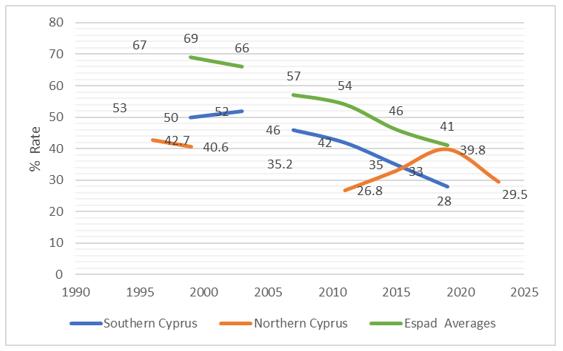
In 1995, Southern Cyprus exhibited lower smoking rates on average than both Northern Cyprus and ESPAD countries. Both regions and ESPAD countries have experienced a gradual decline in smoking rates over the years, while ESPAD has consistently maintained higher averages. From 2015 onwards, this trend reversed in Northern Cyprus, with a gradual increase in smoking rates while both Southern Cyprus and ESPAD countries continued to decline. In 2023, Northern Cyprus experienced a sharp decline in smoking rates in line with the downward trend observed in Southern Cyprus and ESPAD countries. By 2019, Southern Cyprus had the lowest smoking rate among the three organizations (28%). Northern Cyprus exhibited higher smoking rates than Southern Cyprus for the first time in 2019 but experienced a significant decline by 2023. ESPAD countries maintained the highest average smoking prevalence over the period but also showed a consistent downward trend (see figure 2.1.).
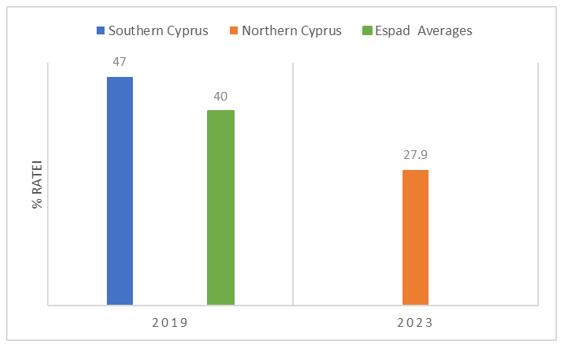
According to 2019 data, Southern Cyprus exhibited a higher prevalence of e-cigarette use (47%) compared to the ESPAD average (40%). Data for Northern Cyprus is not available for this period. In 2023, Northern Cyprus recorded a lower prevalence of e-cigarette use (27.9%) compared to both the Southern Cyprus and ESPAD average observed in 2019 (see figure 2.2.).
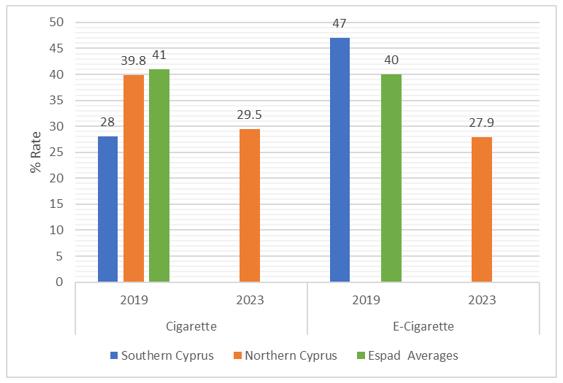
In ESPAD Countries, smoking and e-cigarette use showed similar prevalence in 2019 (41% and 40% respectively). In Southern Cyprus, smoking in 2019 (28%) was below the ESPAD average, while e-cigarette use (47%) exceeded the ESPAD average. In Northern Cyprus, smoking (29.5%) and e-cigarette use (27.9%) showed similar prevalence in 2023. It is seen that e-cigarette use is approaching traditional cigarette use in the average of ESPAD countries and Northern Cyprus. Southern Cyprus exhibits higher e-cigarette use than cigarette use among high school students in recent years (see figure 2.3.).
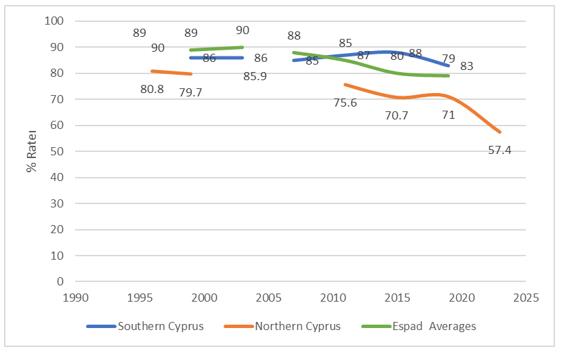
Between 1995 and 2004, Southern Cyprus maintained similar prevalence of alcohol use to the ESPAD average (approximately 89-90%), while Northern Cyprus exhibited lower rates over this period. While ESPAD averages remained relatively stable over the period 1999-2007, both regions remained below average. Southern Cyprus showed a slight downward trend, reaching a minimum of 86%, while Northern Cyprus showed a significant increase and peaking at 85.9%. In the period between 2011-2019, Southern Cyprus exceeded the ESPAD average for the first time in 2011 and consistently exceeded both the average and Northern Cyprus throughout this period. However, by 2019, these rates started to decline and reached a minimum of 83%. Northern Cyprus is downward trend after 2011, reaching the lowest usage rate of 57.4% in 2023 (see figure 2.4.).
How much has the proportion of students using illicit drugs such as cannabis, ecstasy, cocaine etc. changed over time compared to the rates in Northern Cyprus, Southern Cyprus and ESPAD countries?
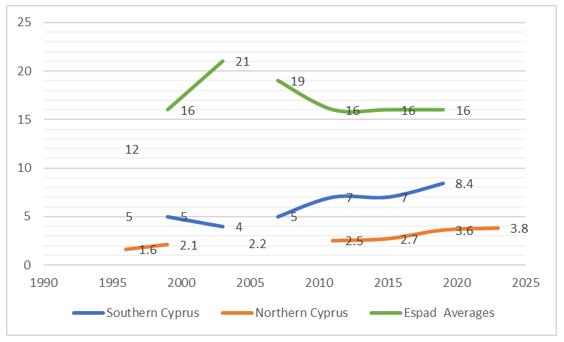
Early Period (1995-1999) Both parts of Cyprus exhibited significantly lower cannabis use compared to the ESPAD average (maximum 16%). Southern Cyprus peaked at 5%, while Northern Cyprus remained very low at 2.1%. Middle Period (2003-2004): ESPAD countries reached the highest average prevalence (21%). Southern Cyprus declined to its lowest point (4%), while Northern Cyprus increased slightly to 2.2%. Next Period (2007-2019): The ESPAD average remained stable at 16% during this period, exceeding both Cyprus regions. Both regions experienced gradual increases, with Southern Cyprus reaching 8.4% by 2019, while Northern Cyprus remained below 4%: Northern Cyprus reached 3.8% in 2023, the highest rate ever recorded (see figure 2.5.).
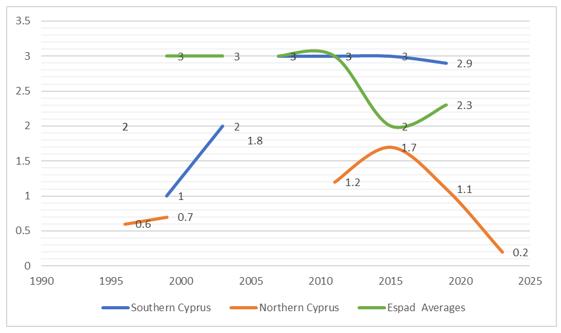
Early Period (1995-1999): Northern Cyprus exhibited the lowest rates of Ecstasy use compared to both ESPAD and Southern Cyprus. Mid-Period (2003-2004): Northern Cyprus experienced a temporary rise in Ecstasy use, reaching 1.8% and nearing Southern Cyprus' 2%. This marked the highest prevalence recorded in Northern Cyprus throughout the period. Later Period (2011 onwards): Southern Cyprus surpassed the ESPAD average in Ecstasy use, suggesting an increasing prevalence within their high school population. Conversely, Northern Cyprus saw a dramatic decline in Ecstasy use after 2015, plummeting to an all-time low of 0.2% by 2023 (see figure 2.6.).
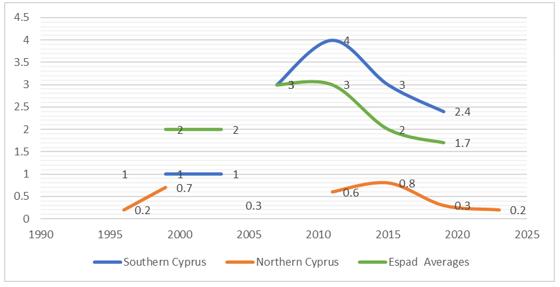
Northern Cyprus throughout the period, amphetamine use remained comparatively low, never exceeding 1% of high school students. Southern Cyprus is initially like Northern Cyprus (around 1%), amphetamine use increased to 3% in 2007, matching the ESPAD average. It peaked at 4% in 2011 but gradually declined thereafter. In 2019, Southern Cyprus exhibited a higher prevalence (2.4%) compared to the ESPAD average (1.7%). Overall trends, both regions and ESPAD countries experienced a decrease in amphetamine use after 2011. However, Southern Cyprus currently displays a higher prevalence than the ESPAD average (see figure 2.7.).
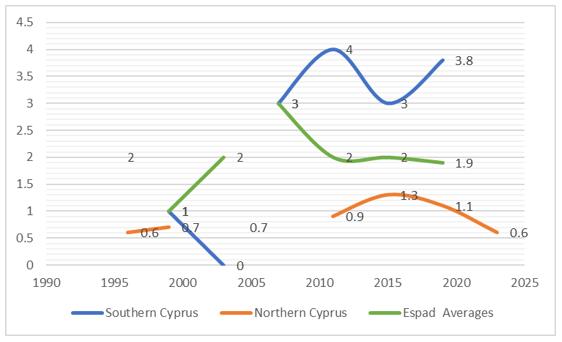
Early Period (1995-1999), Southern Cyprus exhibited higher cocaine use compared to Northern Cyprus. Mid-Period (1999-2007), Southern Cyprus experienced a decline in cocaine use, dropping to 0% by 2003, followed by a rise to 3% by 2007, matching the ESPAD average. Later Period (2011 onwards), Southern Cyprus consistently surpassed the ESPAD average in cocaine use, reaching a peak of 4% in 2011. Conversely, Northern Cyprus maintained rates below the ESPAD average, with a maximum of 1.3% in 2015, followed by a gradual decline reaching 0.6% by 2023 (see figure 2.8.).
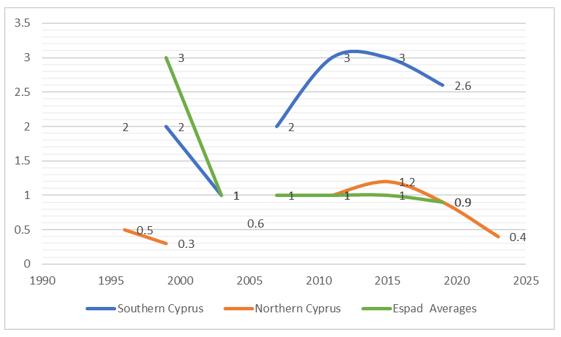
Early Period (1995-2004), Northern Cyprus displayed remarkably low heroin use throughout, reaching a maximum of 0.6% in 2004, consistently below both Southern Cyprus and the ESPAD average (peaking at 3% in 1999). Mid-Period (2007-2015), Southern Cyprus experienced an increase in heroin use, exceeding the ESPAD average with 3% in 2007 and remaining elevated (2.6% in 2019) despite a slight decline. Conversely, Northern Cyprus saw a rise in 2004 but surpassed the ESPAD average only in 2015 (1.2%). Recent Developments (2019-2023), By 2019, both regions and the ESPAD average converged to similar levels (around 0.9%). Northern Cyprus further decreased to 0.4% in 2023, signifying a continued downward trend (see figure 2.9.).
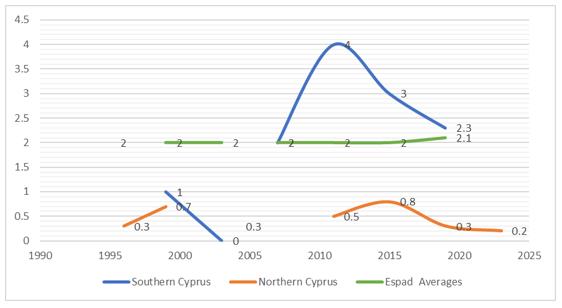
ESPAD average, LSD and hallucinogen use remained remarkably stable at 2% throughout the analyzed period, showing minimal fluctuation with a slight increase to 2.1% in 2019. Northern Cyprus, Rates in Northern Cyprus consistently remained below 1% and the ESPAD average, indicating consistently low prevalence. Southern Cyprus, initially similar to the ESPAD average, Southern Cyprus witnessed a rise in prevalence exceeding the average after 2007, culminating in a peak of 4% in 2011. Then dropped significantly to 2.3% in 2019 (see figure 2.10.).
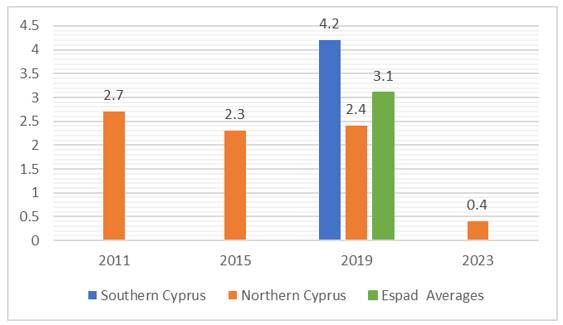
2019, Southern Cyprus exhibited the highest synthetic cannabinoid use (4.2%) compared to the ESPAD average (3.1%) and Northern Cyprus (2.4%). Northern Cyprus, ESPAD data suggests a peak in synthetic cannabinoid use in 2011 (2.7%) followed by a consistent decline to 0.4% by 2023 (see figure 2.11.).
What is the percentage of students in Northern Cyprus who use Anabolic Steroids, Tranquilizers or Sedatives as non-prescription medicines compared to the averages for Southern Cyprus and ESPAD countries?
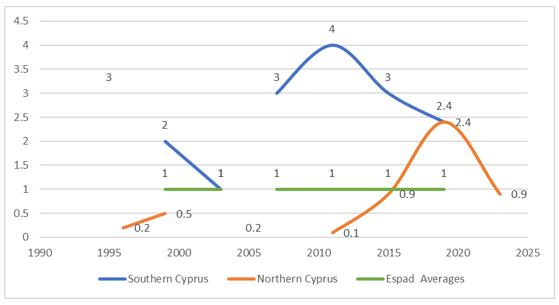
When examining ESPAD data concerning the utilization of anabolic steroids, it becomes apparent that the prevalence of anabolic steroid usage among secondary school students in Southern Cyprus surpasses that of Northern Cyprus in all years except for 2019. While the lowest incidence of high school students employing anabolic steroids in Northern Cyprus occurred in 2011, the frequency of steroid consumption steadily escalated until 2019, ultimately reaching parity with Southern Cyprus. Subsequently, this percentage decreased to 0.9% in Northern Cyprus by 2023 (see figure 2.12.).
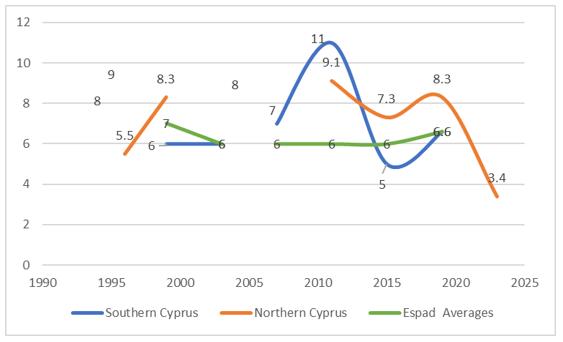
1995-2004, Both ESPAD countries and Southern Cyprus experienced a gradual decline in non-prescription use, while Northern Cyprus saw an increase. 2007-2019, ESPAD countries maintained a stable average around 6%, with a slight increase in 2019. Southern Cyprus displayed a peak in 2011 (11%), followed by a sharp decline to match the ESPAD average by 2019. Northern Cyprus remained above the ESPAD average during this period, exceeding Southern Cyprus' rates between 2015 and 2019, but experiencing a significant drop to 3.4% in 2023 (see figure 2.13.).
Conclusion
This analysis underscores the crucial role of ongoing monitoring and flexible public health initiatives in addressing the dynamic landscape of substance use among Cypriot youth, particularly concerning smoking, e-cigarettes, and alcohol. Understanding the underlying forces shaping these trends is vital for crafting effective interventions to safeguard their health.
The study sheds light on regional disparities in alcohol consumption compared to European averages, urging deeper explorations into local, regional, and global factors at play. Socioeconomic, policy-related dynamics, and individual characteristics must be considered when designing future public health strategies.
While both Cyprus regions initially lagged behind Europe in cannabis use, subsequent shifts mirror global trends, emphasizing the importance of continuous surveillance and policy adjustments. Both regional and pan-European public health and law enforcement approaches require re-evaluation as cannabis use climbs.
Divergent ecstasy uses patterns to highlight the need for location-specific interventions. Southern Cyprus' upward trend, compared to the North, necessitates thorough investigation into underlying causes, societal shifts, and potential policy gaps. Both regions can benefit from mutual learning and best practice adoption, aided by collaborations with organizations like ESPAD.
Understanding the multifaceted influences of socioeconomic, cultural, and policy factors on disparate amphetamine use patterns is crucial for developing targeted treatments and preventive measures. Both Cyprus and the wider European community must adapt their efforts to address the evolving amphetamine use landscape.
This study reveals intriguing interregional differences in cocaine and heroin use over time. Southern Cyprus' fluctuating cocaine use pattern warrants further exploration, while Northern Cyprus' consistently lower rates necessitate tailored public health approaches to their specific drug use dynamics.
Disparities in synthetic cannabinoid, hallucinogen, and LSD use highlight the role of geographical variations in influencing drug prevalence. By understanding these differences and their underlying causes, specific regional actions and policies can be designed to tackle unique challenges.
Finally, the analysis emphasizes the importance of comprehending the diverse factors driving differences in anabolic steroid and non-prescription tranquilizer/sedative use rates across the regions. Examining the influences and strategies employed in both locations is key to developing effective interventions addressing unique needs and issues.
Considering the findings of this study, the multifaceted nature of substance use across Cyprus is underlined, and to effectively address the evolving challenges and protect public health, collaborative monitoring and intervention efforts to prevent substance use between both communities, as well as specific interventions within both regions, are needed. Special monitoring and intervention studies should be implemented according to their needs.
Discussion
This analysis examines the multifaceted landscape of substance use among high school students in Northern and Southern Cyprus, drawing comparisons with the ESPAD average, to illuminate trends and potential influencing factors between 1995 and 2023.
Cigarettes, early observations reveal below-average smoking rates in both regions compared to ESPAD countries, potentially due to effective policies (Joossens & Raw, 2006). Divergent trends emerge later, with Southern Cyprus experiencing an increase and Northern Cyprus initially dropping, followed by an upswing by 2019. Socio-political dynamics and changing regulations might have played a role (Gilmore et al., 2004). The recent decline in Northern Cyprus warrants further investigation into potential interventions.
E-Cigarettes, Southern Cyprus displays an above-average e-cigarette use compared to ESPAD in 2019, while Northern Cyprus shows a lower rate. However, the rising trend in Northern Cyprus by 2023 suggests potential substitution or complementation effects (Warner & Mendez, 2019). The contrasting patterns highlight the evolving nicotine product landscape in the region.
Alcohol, Historically, both regions mirrored the ESPAD average, indicating similar consumption patterns to European counterparts (Hibell & Guttormsson, 2013). However, post-2011, Southern Cyprus surpassed the average while Northern Cyprus maintained a decline. Potential explanations include socio-economic changes impacting consumption (Rehm et al., 2020) and variations in policy interventions (Anderson & Baumberg, 2015). The peak and decline in Southern Cyprus might align with global "sober curious" trends (Peele, 2004).
In the early 2000s, it was revealed that Southern Cyprus experienced a decline, while Northern Cyprus experienced a slight increase, which may have been influenced by global decriminalization movements (Hall & Lynskey, 2016). After some time, both regions experienced a steady rise, possibly due to the growth of international trade and the EU's efforts to integrate (Eurostat, 2019). However, both Northern Cyprus and Southern Cyprus experienced later increases that aligned with broader European trends (Hibell et al., 2004). After 2011, Southern Cyprus experienced an increase in the usage of Ecstasy, possibly influenced by socio-economic factors and the EDM culture (Measham et al., 2001). In contrast, Northern Cyprus experienced a decrease in the usage of Ecstasy after 2015, which might be a result of effective interventions (UNODC, 2016).
Amphetamine use in Northern Cyprus has consistently been lower when compared the use in Southern Cyprus and the ESPAD average, which may offer useful insights for other regions (EMCDDA, 1999; EMCDDA, 2023). In contrast, Southern Cyprus's growing use aligns with the ESPAD average, possibly due to socio-economic changes, shifts in youth culture, and increased drug availability (EMCDDA, 2019).
The use of cocaine displayed distinct patterns, with Southern Cyprus experiencing higher prevalence in the 1990s (EMCDDA, 2020). Although, preventive measures and strategies leading to a decline in Southern Cyprus between 1999 and 2003 (UNODC, 2020), the post-2011 resurgence requires further investigation. On the other hand, Northern Cyprus maintained lower rates, suggesting differing socio-political landscapes.
The trends of heroin usage display disparities which indicate that Northern Cyprus is reporting lower rates compared to Southern Cyprus and the ESPAD average (Degenhardt et al., 2008). Numerous factors, including availability, differences in policies, cultural values, norms, and attitudes, as well as socioeconomic conditions, may contribute to these differences. To tackle this issue, it is crucial and necessary to conduct more research and collaborate on initiatives which will lead to development of effective, region-specific strategies.
The usage rates of LSD and other hallucinogens found to be lower in Northern Cyprus when compared to the average usage rates reported by ESPAD. The reason might be the implementations of educational programs, tighter enforcement of laws and/or cultural norms that discourage the use of illicit substances. However, Southern Cyprus has demonstrated higher rates of usage of such illicit substances that exceeds the ESPAD average, which could be influenced by numerous regulatory, social and cultural factors.
According to the usage rates of synthetic cannabinoids in 2019, Sothern Cyprus reported the highest usage rate, exceeding the ESPAD average. The reason of this may be explained by the high availability and accessibility of such substances, as well as potentially less tighter regulations. On the other hand, Northern Cyprus reported lower prevalence rates of synthetic cannabinoid use in 2019, and the prevalence rates continued to decrease until 2023. These results may suggest that the implementation of successful and effective drug prevention programs, community outreach, and law enforcement measures influenced and lead to a decrease in the usage of synthetic cannabinoid in North Cyprus (UNODC, 2023).
According to the results, anabolic steroid usage appears to be more prevalent in Southern Cyprus when compared to Northern Cyprus, with the exception of year 2019. This disparity may be explained by the numerous educational, regulatory, socio-cultural factors. The decline in the use of anabolic steroid in Northern Cyprus in 2023 may be attributed to increased awareness of health risks, stricter law enforcement, or educational initiatives. It is crucial to conduct further research to determine the effectiveness of these interventions.
The usage of sedatives and non-prescription tranquilizers has generally increased in ESPAD countries between 1995 and 2004, with Northern Cyprus showing particularly concerning rates and a significant increase in 2011. On the other hand, Southern Cyprus experienced an increase in 2011 and continued to have higher than average consumption usage rates compared to Northern Cyprus from 2011 to 2019. Factors such as accessibility, differences in healthcare laws and prescription procedures may play a crucial role in these variations (EMCDDA, 2020). In order to address the issue, further investigation is necessary about regulatory changes, public health initiatives, and socioeconomic and mental health conditions. With the help of this further research, it will be possible to understand the underlying causes and develop effective prevention strategies.
Challenges and Limitations of the Study
This study faces various challenges and limitations that must be taken into account when interpreting its results. Regional discrepancies between Northern and Southern Cyprus as well as differences with ESPAD data complicate understanding substance use patterns. These variations may affect the application of results across different contexts, making it difficult to generalize findings universally. Furthermore, the reliance on self-reported data raises the potential for inaccuracies, as participants may not always provide completely truthful or accurate responses. The socio-political landscapes of both Cypriot regions may influence substance use trends and the effectiveness of treatment strategies, potentially skewing comparative results. Cultural differences and varying regulatory environments further complicate the interpretation of data, hindering the ability to extend conclusions beyond the studied regions.
The study's cross-sectional design restricts its capacity to track changes over time or establish causal relationships. This approach may not fully capture recent trends or emerging patterns in substance use. Additionally, while the study addresses a range of substances, it may overlook other crucial factors influencing substance use, such as mental health issues or broader social dynamics. Finally, focusing specifically on Cyprus and comparing it with ESPAD data may limit the generalizability of the findings to other regions or countries with distinct socio-cultural or economic contexts.
These factors emphasize the need for careful consideration of the study's results and suggest that additional research is necessary to gain a more comprehensive understanding of substance use patterns and to develop effective public health strategies.
References
Agorastos, A. (2010). Evaluation of addiction services in Cyprus. [Doctoral Dissertation]. University Medical Center Hamburg-Eppendorf, Hamburg. Retrieved on September 12, 2023 from https://ediss.sub.uni-hamburg.de/bitstream/ediss/3770/1/ DISSERTATION_AGORASTOS.pdf
Anderson, P., & Baumberg, B. (2015). Alcohol in Europe: a public health perspective. Institute of alcohol studies for the European commission.
Aresi, G., Moore, S., & Marta, E. (2016). Drinking, drug use, and related consequences among university students completing study abroad experiences: A systematic review. Substance Use and Misuse, 51(14), 1888-1904. DOI: 10.1080/10826084.2016.1201116
Carrasco-Garrido, P., Jiménez-Trujillo, I., Hernández-Barrera, V., García-Gómez-Heras, S., Alonso-Fernández, N., & Palacios-Ceña, D. (2018). Trends in the misuse of tranquilizers, sedatives, and sleeping pills by adolescents in Spain, 2004–2014. Journal of Adolescent Health, 63(6), 709-716. DOI:
Çakıcı, M., Tutar, N., Çakıcı, E., Karaaziz, M., & Eş, A. (2017). The prevalence and risk factors of psychoactive drug use in Turkish Republic of Northern Cyprus: 2003-2013. Anatolian Journal of Psychiatry, 18(2), 99-107. DOI: 10.5455/apd.226191
Çakıcı, M., Babayiğit, A., Karaaziz, M., & Eş, A. (2019a). Prevalence of psychoactive substance use, risk factors and investigation of attitudes towards substance use among adult population in TRNC, 2003-2017. Anatolian Journal of Psychiatry, 20(3), 277-286. DOI: 10.5455/apd.4372
Çakıcı, M., Ergün, D., Eş, A., Toprak, A., & Özer, H. (2019b). The prevalence and risk factors of psychoactive substance use among high school students in Turkish Republic of Northern Cyprus, 1996-2019. Anatolian Journal of Psychiatry, 20(special issue.1), 38-41. DOI: 10.5455/apd.302644854
Çakıcı, M., Karaaziz, M., Babayiğit, A., & Eş, A. (2020). Lifetime prevalence and risk factors of drug use in North Cyprus: 2003-2015. Cogent Psychology, 7(1), 1772630. DOI: 10.1080/23311908.2020.1772630
Çakıcı Eş, A., Çakıcı, M., İskender, C., & Kızılgül, Z. (2020). Psychoactive substance use profile and risk factors in TRNC risky regions: TRNC four regions sample. Anatolian Journal of Psychiatry, 21(2), 165-172. DOI: 10.5455/apd.58339
Degenhardt, L., Chiu, W-T., Sampson, N., Kessler, R. C., Anthony, J. C., Angermeyer, M., Bruffaerts, R., de Girolamo, G., Gureje, O., Huang, y., Karam, A., Kostyuchenko, S., Lepine, J. P., Medina Mora, M. E., Neumark, Y., Ormel, J. H., Pinto-Meza, A., Posada-Villa, J., Stein, D. J., Takeshima, T., & Wells, J. E. (2008). Toward a global view of alcohol, tobacco, cannabis, and cocaine use: Findings from the WHO World Mental Health Surveys. PLoSMed 5(7), 1053-1067. DOI:
European School Survey Project on Alcohol and Other Drugs (ESPAD) Report. (2019). Retrieved on September 22, 2023 from http://www.espad.org/espad-report-201
European Monitoring Centre for Drugs and Drug Addiction (EMCDDA) (1999). Annual report on the state of the drugs problem in the European Union. Luxembourg: Office for Official Publications of the European Communities. https://www.emcdda.europa.eu/html.cfm/index37340EN.html_en
European Monitoring Centre for Drugs and Drug Addiction (EMCDDA). (2009). Drug Use: An Overview of General Population Surveys in Europe, Belgian Science Policy Office, Spain. Retrieved on September 12, 2023, from https://www.emcdda.europa.eu/publications/thematic-papers/gps_en
European Monitoring Centre for Drugs and Drug Addiction (EMCDDA). (2014). Cyprus Focal Point Report 2014 by the Reitox National Focal Point, Cyprus. Retrieved on September 10, 2023 from https://www.emcdda.europa.eu/ system/files/publications/988/ NR_2014_Final_for%20EMCDDA.pdf
European Monitoring Centre for Drugs and Drug Addiction (EMCDDA). (2016). European Drug Report 2015: Trends and Developments. Retrieved on September 11, 2023, from https://www.euda.europa.eu/publications/ edr/trends-developments/2015_en
European Monitoring Centre for Drugs and Drug Addiction (EMCDDA). (2019). Cyprus, Country Drug Report 2019, Cyprus National Addictions Authority, Nicosia. Retrieved on September 12, 2023, from https://www.emcdda.europa.eu/publications/country-drug-reports/ 2019/cyprus_en
European Monitoring Centre for Drugs and Drug Addiction (EMCDDA). (2020). European Drug Report 2020: Trends and Developments. Retrieved on September 24, 2023, from https://www.emcdda.europa.eu/publications/ edr/trends-developments/2020_en
European Monitoring Centre for Drugs and Drug Addiction (EMCDDA). (2022). European Drug Report: Trends and Developments, Lisbon. Retrieved on September 12, 2023, from https://www.politicheantidroga.gov.it/media/ 3387/edr_2022_15_final_watermarked.pdf
European Monitoring Centre for Drugs and Drug Addiction (EMCDDA). (2023). European Drug Report 2023: Trends and Developments. Luxembourg: Office for Official Publications of the European Communities. Retrieved on September 24, 2023, from https://www.emcdda.europa.eu/publications/ european-drug-report/2023_en
Eurostat. (2019). 2019 Annual Activity Report. https://commission.europa.eu/ document/download/59ffaa40-9671-4f91-bb8b-cc9b4a0c498a_en?filename=estat_aar_2019_en.pdf
Gilmore, A., Pomerleau, J., McKee, M., Rose, R., Haerpfer, C. W., Rotman, D., & Tumanov, S. (2004). Prevalence of smoking in 8 countries of the former Soviet Union: results from the living conditions, lifestyles and health study. American journal of public health, 94(12), 2177-2187. DOI:
Hall, W., & Lynskey, M. (2016). Evaluating the public health impacts of legalizing recreational cannabis use in the United States. Addiction, 111(10), 1764-1773. DOI:
Hefner, K. R., Sollazzo, A., Mullaney, S., Coker, K. L., & Sofuoglu, M. (2019). E-cigarettes, alcohol use, and mental health: Use and perceptions of e-cigarettes among college students, by alcohol use and mental health status. Addictive behaviors, 91, 12-20. DOI:
Hibell, B., & Guttormsson, U. (2013). A supplement to the 2011 ESPAD Report. Additional data from Bosnia and Herzegovina (Federation of Bosnia and Herzegovina), Kosovo (under UNSCR 1244) and the Netherlands. Stockholm: The Swedish Council for Information on Alcohol and Other Drugs.
Hibell, B., Andersson, B., Bjarnasson, T., Ahlström, S., Balakireva, O., Kokkevi, A., & Morgan, M. (2024). The ESPAD Report 2003 Alcohol and Other Drug Use Among Students in 35 European Countries. The Swedish Council for Information on Alcohol and Other Drugs, CAN Council of Europe, Co-operation Group to Combat Drug Abuse and Illicit Trafficking in Drugs (Pompidou Group). http://www.espad.org/sites/espad.org/files/ The_2003_ESPAD_report.pdf
Hughes, K., Bellis, M. A., Hardcastle, K. A., McHale, P., Bennett, A., Ireland, R., & Pike, K. (2015). Associations between e-cigarette access and smoking and drinking behaviours in teenagers. BMC public health, 15, 1-9. DOI: 10.1186/s12889-015-1618-4
Joossens, L., & Raw, M. (2006). The Tobacco Control Scale: a new scale to measure country activity. Tobacco control, 15(3), 247-253. DOI:
Kapardis, A., Spanoudis, G., Kapardis, C., & Konstantinou, M. (2021). Cyprus. In D. P. Farrington, H. Jonkman, & F. Groeger-Roth (Eds.), Delinquency and Substance Use in Europe (pp. 97-113). Springer, Cham. DOI: 10.1007/978-3-030-58442-9_6
Kokkevi, A., Fotiou, A., Arapaki, A., & Richardson, C. (2008a). Prevalence, patterns, and correlates of tranquilizer and sedative use among European adolescents. Journal of Adolescent Health, 43(6), 584-592. DOI: 10.1016/j.jadohealth.2008.05.001
Kokkevi, A., Fotiou, A., Chileva, A., Nociar, A., & Miller, P. (2008b). Daily exercise and anabolic steroids use in adolescents: a cross-national European study. Substance use & misuse, 43(14), 2053–2065. DOI:
Kyprianou, E., Mina, Ch., Stylianou, K., Yiasemi, I., Gaist, B., SymeonidouE., Matheou, M., & Mavrou, J. (2023). National implementation of quality standards in prevention and treatment services for substance use/addictions – A case study of Cyprus. Adiktologie, 23(1), 41–46. DOI: 10.35198/01-2023-002-0004
Lehne, G., Zeeb, H., Pischke, C. R., Mikolajczyk, R., Bewick, B. M., McAlaney, J., Robert C. Dempsey, R. C., Van Hal, G., Stock, C., Akvardar, Y., Kalina, O., Orosova, O., Aguinaga-Ontoso, I., Guillen-Grima, F., & Helmer, S. M. (2018). Personal and perceived peer use and attitudes towards use of non-prescribed prescription sedatives and sleeping pills among university students in seven European countries. Addictive Behaviors, 87, 17-23. DOI: 10.1016/j.addbeh.2018.06.012
Lo, T. W., Yeung, J. W., & Tam, C. H. (2020). Substance abuse and public health: A multilevel perspective and multiple responses. International journal of environmental research and public health, 17(7), 2610. DOI: 10.3390/ijerph17072610
Measham, F., Aldridge, J., & Parker, H. (2001). Dancing on Drugs. Risk, health and hedonism in the British club scene. Free Association Books.
Münzel, T., Hahad, O., Kuntic, M., Keaney Jr, J. F., Deanfield, J. E., & Daiber, A. (2020). Effects of tobacco cigarettes, e-cigarettes, and waterpipe smoking on endothelial function and clinical outcomes. European heart journal, 41(41), 4057-4070. DOI: 10.1093/eurheartj/ehaa460
National Institute on Drug Abuse (NIDA). (2018). Steroids and other appearance and performance enhancing drugs (APEDs). Retrieved on September 24, 2023, from https://nida.nih.gov/sites/default/files/815-steroids-and-other-appearance-and-performance-enhancing-drugs-apeds.pdf
Northern Cyprus Anti-Drug Commission. (2021). Northern Cyprus Substance and Addiction Report 2021, Nicosia.
OECD/European Union. (2016), Use of illicit drugs among adults, in Health at a Glance: Europe 2016: State of Health in the EU Cycle, OECD Publishing, Paris. DOI: 10.1787/health_glance_eur-2016-31-en
Peele, S. (2004). The surprising truth about addiction. Psychology Today, 43-46. DOI:
Rehm, J., Kilian, C., Ferreira‐Borges, C., Jernigan, D., Monteiro, M., Parry, C. D., Sanchez, Z. M., & Manthey, J. (2020). Alcohol use in times of the COVID 19: Implications for monitoring and policy. Drug and alcohol review, 39(4), 301-304. DOI:
Room, R. (2005). Stigma, social inequality and alcohol and drug use. Drug and alcohol review, 24(2), 143-155. DOI: 10.1080/09595230500102434
Skidmore, C. R., Kaufman, E. A., & Crowell, S. E. (2016). Substance use among college students. Child and Adolescent Psychiatric Clinics, 25(4), 735-753. DOI: 10.1016/j.chc.2016.06.004
Tecel Tremeşeli, T. T. (2022). An Assessment of Addiction Research on Students in Northern Cyprus. In A. Güneyli, & F. Silman (Eds.), ICEEPSY 2022: Education and Educational Psychology, vol 3. European Proceedings of International Conference on Education and Educational Psychology (pp. 55-64). European Publisher. DOI:
United Nations Office on Drugs and Crime (UNODC). (2016). World Drug Report 2016. Retrieved on September 10, 2023, from https://www.unodc.org/doc/wdr2016/WORLD_DRUG_REPORT_2016_web.pdf
United Nations Office on Drugs and Crime (UNODC). (2018). World Drug Report 2018. Retrieved on September 10, 2023, from https://www.unodc.org/wdr2018/
United Nations Office on Drugs and Crime (UNODC). (2020). World Drug Report 2020, Retrieved on September 24, 2023, from https://wdr.unodc.org/wdr2020/en/index2020.html
United Nations Office on Drugs and Crime (UNODC). (2022). World Drug Report 2018. Retrieved on September 10, 2023, from https://www.unodc.org/unodc/en/data-and-analysis/world-drug-report-2022.html
United Nations Office on Drugs and Crime (UNODC). (2023). World Drug Report 2023, Retrieved on September 24, 2023, from https://www.unodc.org/unodc/en/data-and-analysis/world-drug-report-2023.html
Warner, K. E., & Mendez, D. (2019). E-cigarettes: comparing the possible risks of increasing smoking initiation with the potential benefits of increasing smoking cessation. Nicotine and Tobacco Research, 21(1), 41-47. DOI:
Copyright information

This work is licensed under a Creative Commons Attribution-NonCommercial-NoDerivatives 4.0 International License.
About this article
Publication Date
30 August 2024
Article Doi
eBook ISBN
978-625-98059-2-4
Publisher
Emanate Publishing House Ltd.
Volume
-
Print ISBN (optional)
-
Edition Number
1st Edition
Pages
1-197
Subjects
Addiction, Substance Abuse, Northern Cyprus
Cite this article as:
Bekiroğulları, Z. (2024). Comparative Analysis of Substance Use Across Cyprus: Analyzes the Differences and Similarities in Substance Use Between North and South Cyprus. In N. Dağlıoğlu, & S. Kılıç Akıncı (Eds.), The Landscape of Substance Abuse in Northern Cyprus: Trends, Risks, and Responses, vol -. (pp. 22-54). Emanate Publishing House Ltd.. https://doi.org/10.70020/BI.20240801.2

